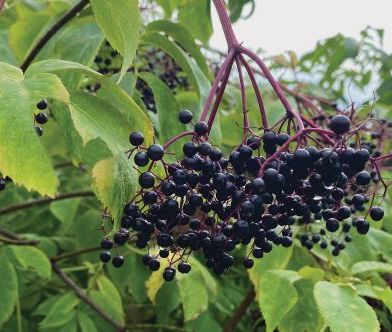Made in the Shade — Fruits You Can Grow in Part Sun
By Janet Scheren, Fairfax Master Gardener

Red Gooseberries
Homes in Fairfax County often come with beautifully treed backyards. While you can grow lettuce and other greens in these conditions, the options for growing fruit are limited because most fruit requires full sun. If you’re willing to be a little creative, however, some fruit can grow nicely in part shade or filtered sunlight.
Gooseberries, red currants and elderberries are the most shade tolerant fruit we can grow in Northern Virginia. Blueberries and some figs will produce a decent crop in light to moderate shade. Serviceberries, pawpaws and cherry trees are small, understory trees that can bear abundant crops.
Red Currants
Red currant shrubs are highly ornamental especially when flush with their bright red berries. Some varieties tolerate partial sun or moderate shade. Black currents are banned from Virginia, but even red currants should be kept 900 ft. away (275 m) from white pines because they can carry a fungus that causes white pine blister rust.

Elderberries
Elderberries
An elderberry shrub can thrive in partial shade and produce fragrant (and edible) flowers along with dark purple berries. The berries can be used in wines, jams and even a homemade flu remedy. Elderflowers have an unmistakable scent and flavor. The blossoms are especially prized in making Elderflower cordial, a nonalcoholic syrup, which can be used to make a refreshing summer lemonade. It can be added to champagne or other beverages or mixed into desserts, where it imparts an amazing fragrance. If frozen in ice cube trays, it will keep well into the new year.
Gooseberries
Gooseberry brambles are grown for their fruit and as a hedging for privacy in your shady yard. Because these plants bloom very early in spring, they are susceptible to late season freezes. Choose a site that warms up slowly in the spring, to minimize this possibility. Gooseberries grow well in moist soil and the addition of organic material such as shredded peat or compost to the soil. This is a winning combination for those of us with low-lying backyards that are often quite damp. Depending on the variety, gooseberries range from sweet to mildly tart.
Blueberries
Most blueberry bushes require at least six hours of direct sun each day, but lowbush blueberries tolerate part shade. They also require highly acidic /fungal soil with a pH between 4.5 and 5.5. The trade-off is a crop of nutritious fruit, white blossoms in spring and beautiful fall foliage.
Figs
Some fig varieties do well in part sun, especially when positioned near a south-facing wall and protected from strong afternoon sun. They also grow well in containers and can be moved as necessary to maximize available light.
Serviceberries
Birds love these native trees and shrubs that produce fruit, which resembles small apples. Serviceberries can be made into jams and jellies and canned.

Serviceberries
In addition to these berries and drupes, several understory trees bear fruit. Pawpaws and even some cherry trees do well with eastern or southern exposure as an understory tree and protection from strong late afternoon sun.
Keep in mind that the quality of fruit — even for these shade tolerant crops — increases with higher light exposure. More intense light levels produce higher sugar levels and more intense and complex flavor. On the other hand, too much sun can produce sun scald or burn. For many of these fruits, direct morning sun with afternoon shade is the perfect solution. Six hours of sun is great for many of these crops. However, dappled sun through the canopy is particularly good for serviceberries, blueberries, gooseberries and currants. They actually thrive in filtered light. Fertilize regularly to encourage a large harvest.
If your backyard has deep shade, and you don’t want to or can’t remove some of the trees, consider limbing up trees or thinning the canopy to let more light through. In addition to allowing more sunlight in, this has the additional benefit of increasing air circulation and allowing rainfall to reach the soil. The increased air circulation can also reduce the risk of fungal disease.
You can also incorporate these fruits in creative ways that might give them more exposure to sun and add beauty to the landscape. Think groundcovers, edgings, hedges and fences. For example, elderberries, which can grow to more than 12 feet tall (4 m), can form a thick hedge. Gooseberries can provide a formidable thorny hedge, growing 3 to 6 feet (1 to 2 m). Alpine strawberries make great groundcovers in these shadier conditions.
Resources
Home Grown Pantry by Barbara Pleasant
Grow Great Virginia Vegetables by Ira Wallace
Small Fruit in the Home Garden, Virginia Cooperative Extension
Virginia’s Home Garden Vegetable Planting Guide: Recommended Planting Dates and Amounts to Plant, Virginia Cooperative Extension